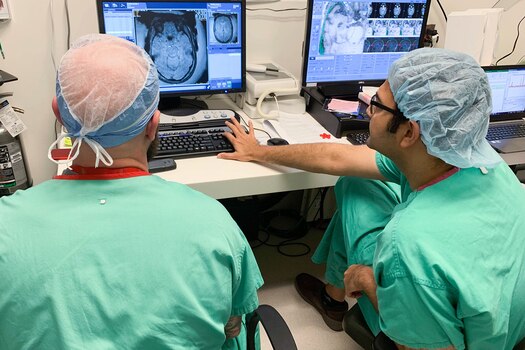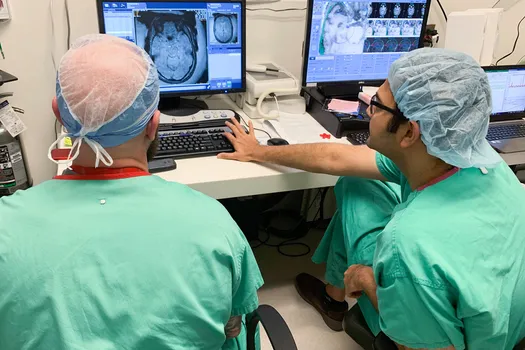Learn about brain health and nootropics to boost brain function
Breaking the Ultrasound Barrier to Fight Disease


May 29, 2019 -- When David Schorr was 56, the then-mortgage consultant in Columbus, OH, noticed some changes in his memory and thinking.
Three years later, the 59-year-old searches for the words to describe it. “It wasn’t sudden, but over time, I knew in my mind that something was different. I wasn’t able to manage some of the stuff that I had been doing before.” He speaks slowly and carefully. “I found that people were seeing what was going on with me. As that went on, it came to a head. I was diagnosed with Alzheimer’s.”
David Schorr and his wife, Kim, went to the Ohio State University Wexner Medical Center for treatment. David Schorr got medications to ease some of the symptoms. But without medicines to cure or slow the progress of the disease, their only other option was experimental treatments.
“They asked us from the beginning if we were interested in clinical trials,” says Kim Schorr. This year, they found a match. But the treatment, Kim says, sounded intense.
Researchers would shave David Schorr’s head, then use ultrasound waves to try to open his blood-brain barrier -- that’s the shield made of blood vessels that protects the brain from any germs or other threats that may be circulating in the bloodstream. The blood-brain barrier mostly keeps the brain healthy by keeping infection out. But when a disease like Alzheimer’s is in the brain, that barrier can prevent helpful medicine from getting in.
Ultrasound to open the blood-brain barrier in Alzheimer’s disease is the latest in the growing field of focused ultrasound. Most people think of ultrasound as a way to take fuzzy black-and-white pictures of a fetus in the womb. But with focused ultrasound, doctors use the sound waves to actively treat a condition rather than passively produce images of it. It’s already an FDA-approved treatment for essential tremor and is an approved treatment for Parkinson’s disease outside the United States. That’s under review here as well.
The technique is also making waves in research into breast cancer, diabetes, and people with brain tumors, Lou Gehrig’s disease (also called amyotrophic lateral sclerosis, or ALS), and mental illnesses, such as severe depression.
“Because focused ultrasound has such a powerful combination of features -- it’s an entirely unique and minimally invasive tool that can trigger a variety of responses in the body -- it has tremendous potential for treating a host of medical problems,” says Richard Price, PhD, who is research director at the University of Virginia Focused Ultrasound Center. “There are probably many applications for focused ultrasound that we haven’t even begun to contemplate yet.”
Kim Schorr says she is hopeful using ultrasound can help her husband. “If it helps him, that would be great. And if it doesn’t, then at least maybe it will help somebody someday. If it can help anyone, we would love it.”
In the clinical trial, researchers want to test a few things. First, whether it is even possible to open the blood-brain barrier. Second, that doing so won’t hurt the person. And finally, that the barrier will close back up later. The major risk of opening the blood-brain barrier is that it would stay open and put patients at risk of infections that could threaten their lives. In phase I clinical trials like this one, the goal is only to see if a treatment is safe. It’s not expected to cure a person or improve their situation.
Schorr has now had three ultrasound sessions, and his blood-brain barrier closed on its own within hours of each. The same has been true for patients at Sunnybrook Health Sciences Center in Toronto, where researchers were the first in the world to open the blood-brain barrier in a person with Alzheimer’s disease.
If the procedure is deemed safe, researchers will move to the next phase -- to see if they can deliver medicine straight to the brain once the blood-brain barrier is open, and to see if that helps treat the disease.
But the treatment may bring about some positive benefits all on its own, without adding medication to it. “It may be that just opening the blood-brain barrier by itself may permit the body's own immune system to get into the brain and clear some of that amyloid [plaque that builds up in the brain in Alzheimer’s],” says Nir Lipsman, MD, PhD, a scientist at Sunnybrook Health Sciences Center.
Early experiments at Sunnybrook found that the ultrasound technique alone cut brain plaque -- deposits that build up in the brain that are believed to cause memory problems -- in mice. Researchers at Sunnybrook, Ohio State, and other hospitals are now seeing if the same will be true in people.
Steadying a Shaky Hand
Rich Powley’s hands started to shake when he was 57 years old. His doctor told him he had what’s called essential tremor. The neurological disorder can affect any part of the body, but it often strikes the hands, especially the dominant hand. It tends to come in older age and can get worse over time.
“If a person with this condition wants to grab something, like a coffee cup, as they intensify their focus on grabbing that object, the tremor gets worse and worse,” says Price.
Powley’s doctor gave him medicine for the tremor, but the side effects -- nightmares, extreme drowsiness, weight loss, and always feeling cold -- were worse than the tremor, he said. Over the course of 26 years with the tremor, by the time Powley was 83 years old, he could no longer create oil paintings the way he used to. He had to hold the brush with both hands. He had to give up using axes, saws, and power tools on the 2-mile stretch of Appalachian Trail he maintains near his home in Free Union, VA. He couldn’t shave or put sugar in his coffee. He wore a bib when he ate.
“I tried not to get depressed,” he says. “I tried changing the way I do things. But I had to rely on my wife for a lot of things.”
Then, this year, Powley’s doctor at University of Virginia Health System asked him if he’d like to try focused ultrasound for the tremor in one of his hands. In this procedure, doctors use MRI to find the nerve cells in the brain causing the tremor. They then fit the patient with a customized helmet that delivers ultrasound waves to the exact spot causing the problem. The ultrasound waves heat up the tiny bit of culprit brain tissue and destroy it.
“You essentially cut the misfiring circuit and restore the patient’s ability to use their hand much better,” says Price.
Before the neurosurgeons started the treatment on Powley, he had to write his name and draw a spiral on paper. “While I was in the [MRI] machine,” Powley explains, “they would roll me out every once in a while and give me the sheet of paper and pencil, and I would try to go around in a circle again. That would tell them how well they were doing.”
For 2 hours, they rolled Powley in and out of the machine to check their work until finally everyone was satisfied. “They pulled me out, and I went through the test with the pencil and paper again, and I could write again.”
Powley is back to painting and, he says, “I can eat my breakfast with a spoon, without a bib. It’s just like a normal breakfast, and I am so happy.”
While the procedure got rid of the tremor in Powley’s right hand, it may not have the same effect on everyone. On average, people get about a 50% improvement in the use of their hands or the area that has the tremor. And like any other medical procedure, this one comes with risks. Some possible side effects include numbness or tingling in the fingers, headache, and unsteadiness. And there is a chance that the procedure can make it hard to walk or make you lose control of some body movements, such as speaking or picking things up.
Sending Up a Flare from Breast Tumors
Focused ultrasound waves may be useful in places besides the brain. Researchers at the University of Virginia are using the technology to try to trigger an immune system attack against cancer. Cancer cells have traits that allow them to trick the immune system -- the body’s built-in defense system. The system recognizes the flu, colds, and other infections as a threat and attacks them. But cancer often manages to sneak by.
New immunotherapy drugs can help the body’s natural defense system recognize cancer as a threat. These drugs are working in melanoma, lung cancer, and others. But sometimes, for example in breast cancer, they may not be enough to wake the immune system up.
In experiments at the University of Virginia, when a woman starts immunotherapy for breast cancer, she also gets a specialized ultrasound treatment. Doctors use ultrasound waves to destroy a few cancer cells on the surface of the breast tumor. The inflammation can alert the immune system and trigger an attack.
“The idea with ultrasound is that the heat stress will cause the immune system to recognize the cancer cells and fight them,” says Price.
This research is still getting its start, but “so far, we see some really exciting changes in how the tumor is behaving after it gets hit with the focused ultrasound,” says Price.
Pushing the Boundaries of Ultrasound
Researchers don’t believe they have exhausted all the possibilities when it comes to ultrasound.
In other early experiments -- not yet in people but showing good results so far in mice -- biomedical engineers at General Electric Global Research have managed to lower blood sugar by focusing ultrasound waves on nerve cells in the liver that help regulate blood sugar. They also lessened inflammation and made arthritis less severe in mice by targeting ultrasound near the spleen. The technology, if proven safe and effective in people, could one day be a noninvasive, nondrug treatment for these conditions.
“We’re using the ultrasound to cause a release of [chemical substances] in the body to have a drug-like effect,” says Christopher Puleo, PhD, a researcher at General Electric involved in the experiment.
The Schorrs are glad to help lay the groundwork for what might one day cure or vastly improve fatal brain diseases. “It’s a lot of appointments, testing, bloodwork, MRIs and PET scans,” says Kim Schorr, “but we think it’s worth every bit of it. You only stand to help somebody.”
Click here to view full article